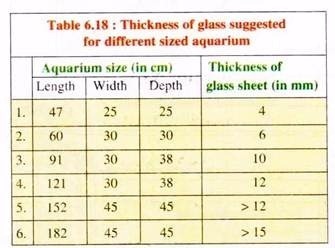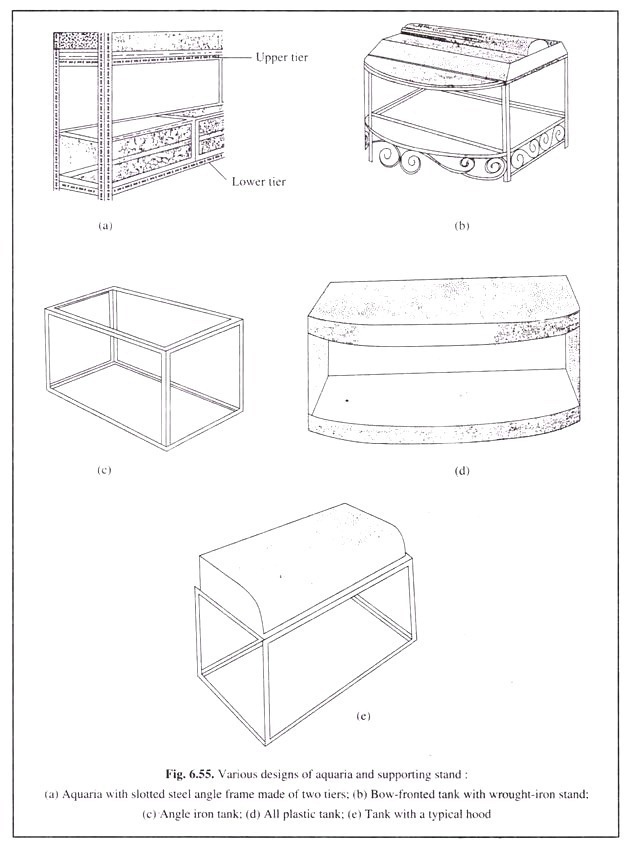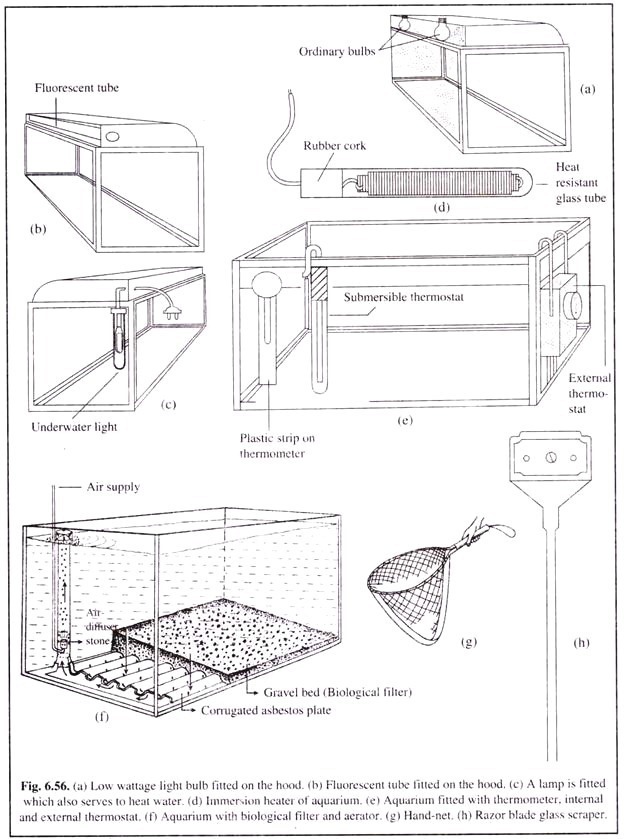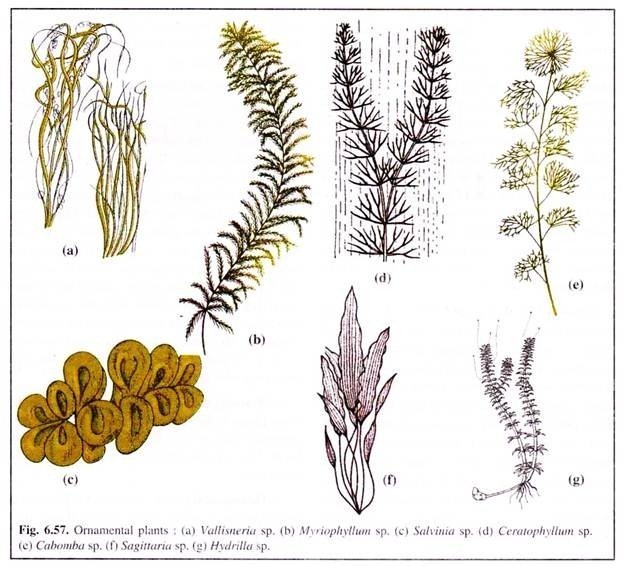In this article we will discuss about the Aquarium:- 1. Setting up of an Aquarium 2. Requirements for Construction of an Aquarium 3. Installation. Also learn about the precautions to be taken for an ideal aquarium.
Setting up of an Aquarium:
While setting up an aquarium two factors are to be considered:
(1) Size – which will be determined by the type of fish to be maintained and the dimension of the intended site, and
(2) Weight – a factor which should not be overlooked.
ADVERTISEMENTS:
Different types of tanks are in use as given in Table 6.17. The most suitable size for home is 18 gallons aquarium of size 60 X 30 X 30 cm. Standard sizes usually starts at 45 X 25 X 25 cm (18″ X 10″ X 10″). A tank of 60 X 30 X 30 cm (24″ X 12″ X 12″) requires adequate support. Any flat surface can suffice to hold a fish tank, but it is preferable to use a stand. Various kinds of stands are available.
However, for a standard sized aquarium a matching stand can be purchased or made. Metal stands of slotted steel angle frames may be comprising one, two or three tiers (Fig 6.55). The main frame should be made of sufficient thickness.
Frames are usually of angle iron to provide the necessary rigidity and strength. For smaller tanks, pressed steel can safely be used, but care should be taken that it does not rust.
ADVERTISEMENTS:
To avoid rust alternative methods for constructing an aquarium can be used:
(i) Aquaria Made Completely with Glass:
The all glass aquaria with the bottom, sides and ends made of glass sheets cemented together with 100 % silicone sealant has been very successful. Handling these glass aquaria should be done with utmost care.
(ii) Aquaria Made of Plastic:
ADVERTISEMENTS:
They are less expensive than glass and are made of flat sheets of clear and coloured perspex cemented together. These tanks cannot be made of large size as the perspex is flexible in nature. Also, in due course these tanks may become full of scratches.
(iii) Using Fibre Glass Frame and Base for Aquarium:
For the front, back and sides of the aquarium, normal fibre glass is used. The fibre glass is hard. It is non-corrosive and can be obtained in a variety of colours.
While selecting any type of aquarium, it is essential to note that it is of sound construction. It is preferable to have shallow and wide tanks as they have more surface area to facilitate oxgenation through atmospheric contact. Also, such tanks can accommodate more number of fishes, than tanks having lesser surface area but equal quantity of water.
Requirements for Construction of an Aquarium:
For construction of an aquarium the following primary things are required:
1. Glass Sheet 2. Silicone 3. Masking or Duct Tape 4. Caulking Gun 5. Aquarium Hood 6. Aquarium Stand 7. Lighting Devices 8. Heating Devices 9. Thermometers 10. Thermostats 11. Composts 12. Aquarium Filters 13. Aerators and Diffusers 14. Planting Sticks 15. Ornamental Plants 16. Feeding Rings and 17. Hand-Net 18. Scrapers or Algae Cleaners 19. Siphon Tube 20. Water Testing Kits.
1. Glass Sheet:
For construction of a rectangular shaped aquarium of size 60 x 30 x 38 cm or 60 x 30 x 30 cm, five sheets of 6 mm thick “plate” glass, also known as “sheet” or “annealed” glass are taken. The thickness of the glass sheet would vary depending upon the size of the aquarium (Table 6.18).
Tempered glass should not be used. The edges of each glass sheet should be made smooth with a dry abrasive paper or the glass shop may be asked to sand or grind the edges.
2. Silicone:
One should be careful as to the type of silicone to be used. Aquarium silicone sealent is the same as regular household silicone, which is without the anti-mildew chemicals added to it. Silicone marketed for aquarium use is much more expensive.
Anti-mildew chemicals slowly release toxin over time which is toxic to both fresh and salt water fishes. Thus, the silicone to be used for aquarium making should not contain the anti-mildew chemicals. Therefore, the 100% silicone sealant should be used.
3. Masking or Duct Tape:
The masking tape is used to cover the edges of the aquarium.
4. Caulking Gun:
Into it is put the silicone sealant and the caulking gun is used to lay it in a straight line on the glass.
5. Aquarium Hood:
A slant hood or lid is put on the roof of the aquarium to prevent entry of any undesirable things or creatures and also to prevent fishes from jumping out of water. The hood is generally made of aluminium sheet and often painted colourfully.
6. Aquarium Stand:
Aquarium can be placed on a table or on an aquarium stand. A variety of attractive, beautifully designed iron stands (Fig. 6.55a & b) are available, which would enhance the beauty of the room.
7. Lighting Devices:
Direct sunlight on the aquarium must be avoided as it causes algal growth and turns the water green. However, proper illumination in the aquarium is important as it not only makes the fishes visible but also enhances the beauty of the tank. It is better to provide light artificially.
Fluorescent tubes (Fig. 6.56b) are preferred to ordinary light bulbs (Fig. 6.56a) as these have a longer life and provides bright light. A special tube, ‘Gro-lux’, is available in the market which encourages plant growth.
Decorative lights can also be used. Some aquarists use underwater lighting, which not only provides light but also helps to heat the water (Fig. 6.56c).
8. Heating Devices:
To maintain the temperature during winter and particularly in places where the temperature goes down to about 1 °C, it is essential to have a heating device. Generally an immersion heater is used for the purpose (Fig. 6.56d).
The heater consists of an element wound round an insulated core and is contained in a heat-resistant glass tube. A rubber cork is fitted at the mouth of the glass tube through which the electric cable is held tightly and it acts as a water seal. Also, as mentioned above a lighting cum heating device (Fig. 6.56e) can also be used.
9. Thermometer:
A thermometer is installed at vertical position to record the changes of temperature of the aquarium water. The common type available in the market has a glass tube mounted on a scaled, plastic strip which is held in position in the aquarium by a rubber sucker pad (Fig. 6.56e).
10. Thermostat:
The temperature in a tropical aquarium should be maintained at a range of 18-29°C, depending upon the species. This temperature can be maintained by installing thermostats which are generally of two types. The internal thermostat is installed either partially or fully submerged in water, while the external thermostat is fixed outside the tank (Fig. 6.56e). Temperature, however, will always fluctuate a few degrees around the point set by the thermostat.
11. Composts:
For aquarium without filter, composts are used. An aquarium compost is the gravel which is made up of small stones and pebbles, or a mixture of these with sand. The compost is first washed thoroughly and then spread at the tank bottom, on which plants can be grown.
12. Aquarium Filters:
The purpose of filters in aquarium is filtration of water, removal of waste food and decaying plant leaves, and providing fishes and plants with clean water.
A variety of filters are in use in aquarium which can be grouped in the following three types:
(i) Mechanical Filters:
Mechanical filters are simple pumps containing a nylon filter wood or a foam cartridge. When the water of the aquarium is passed through it, the suspended perticulate matters are trapped and effectively removed from the water. The filters are then regularly cleaned.
(ii) Chemical Filter:
Chemical filter uses the absorptive properties of activated carbon. This tiny activated carbon attracts and removes from the aquarium water the dissolved organic waste products and other particles.
(iii) Biological Filters:
Biological filters comprises a corrugated and porous asbestos or acrylic- plate fixed slightly above the bottom with a non- soluble adhesive on all the sides of the tank (Fig. 6.54f). A narrow glass cylinder of 8 cm diameter and open at both ends is inserted through an opening made at one side of the plate.
Through this cylindrical glass wear circulation and aeration are done. After the plate is fixed, gravel is spread over the floor of the plate to a height of 5-7 cm. Then well-washed granite and suitable colourful aquarium stones are embedded in the gravel terrace.
Care should be taken such that the gravel is not coarse as food particles may get caught in the interspaces of the gravel and the food would be beyond the reach of the fish. Moreover, the water would percolate faster through the coarse gravel and the efficiency of the biological filter would be affected, owing to the limited surface area and poor development of bacteria.
Importance of Biological Filter:
The excretory products of fishes, the dead plants and organisms, and uneaten food, rich in nitrogen compounds would accumulate at the bottom and cause pollution of the aquarium water. Ammonia, a toxic gas, is formed directly through the excretion of gills and indirectly from various excretory products such as urea, uric acids and amino-acids.
Concentration of ammonia beyond 0.5 mg/litre is toxic to fishes which would result in the haemoglobin of blood to loose its ability to combine with oxygen or to liberate carbon dioxide. Aquarium fishes excrete ammonia in the range 0.3-4.0g/kg of fish/day.
Ammonia content also increases with an increase in pH (10 times at one unit increase in pH). Therefore, it is necessary to oxidase ammnia to nitrite (NO2) and subsequently to nitrate (NO3), which is non-toxic up to 400 mg/litre and it is taken up by the plants during photosynthesis.
The ammonia rich water in the aquarium passes through the gravel bed and filter plate, and accumulates at the bottom of the aquarium below the biological filter. While passing through the gravel bed, the aerobic nitrifying bacteria (Nitrosomonas and Nitrobacter) that accumulate naturally in the gravel bed due to constant circulation of water, act upon the ammonia rich water.
The Nitrosomonas oxidises ammonia to nitrite, which is further oxidised to nitrate by Nitrobacter. The purified nitrate rich water which percolates into the lowest chamber of the aquarium, is lifted up to the surface by the cylindrical glass which is fitted with an aerator, thereby circulating the water again and again.
13. Aerators and Diffusers:
Generally partial water changes in every two weeks may be adopted. Alternately, to maintain proper oxygen content in the aquarium water, particularly in the night (when there is no photosynthesis), it is essential to aerate the water. Aeration can be done by providing a small piston or diaphragm-type aerator, polythene tubing and an air-diffuser stone (Fig. 6.56f).
The diffuser stone is lodged in the glass cylinder that has been set up in the porous asbestos or plate while setting the biological filter in the aquarium. When air is blown into the polythene tube, the air reaches the air-stone and owing to its porous nature air bubbles are released which rise to the surface and oxygenate the aquarium water.
It is advisable to take precautionary measures to clean the porous stone as it often gets chocked with suspended particles.
14. Planting Sticks:
When it is desired to plant some plants in between the rocks, planting stick is generally used, as it is difficult to reach with bare hands. The planting stick is made of thin wood or metal strip.
15. Ornamental Plants:
Presence of plants in an aquarium serves several functions as follows:
(i) It provides shelter, shade and sanctuary for fishes,
(ii) It decorates the aquarium,
(iii) They serve in spawning,
(iv) They serve as food for certain fishes.
(v) They utilise the carbon dioxide (waste of fishes) and liberate oxygen through photosynthesis and
(vi) They absorb the nitrate, converted from ammonia by the biological filter.
Several types of plant are available, but hardy aquatic plants of quick growing types should be considered by an aquarium keeper. Aquarium plants (Fig. 6.57) may be of two types — rooted plants and floating plants.
Among rooted plants are Vallisneria sp. (tape grass) (Fig. 6.57a), Myriophyllum sp. (Milfoil) (Fig. 6.57b), Amazon sored (colourful long leaves) and Crystocdmiyes sp. (coloured broad leaves); whereas floating plants comprise Salvinia sp. (long leaves) (Fig. 6.57c) and Crystal worth (small leaves).
Other important plants are Ceratophyllum sp. (Fig. 6.57d), Clodia sp., Fontinalis sp., Cabomba sp. (fanwort) (Fig. 6.57e), Sagittaria sp. (Fig. 6.57f), Chara sp. (stonewort), Hydrilla sp. (Fig. 6.57g), etc.
Before planting, the plants should be washed thoroughly so that no parasites can enter the aquarium and cause the death of fishes. These plants are disinfected by rinsing in 0.1 per cent solution of alum (potassium-aluminium sulphate) followed by washing in water.
The plants are carefully installed by the planting stick. Large, wide plants like the tape grass (Vallisneria sp.) may be placed at the back of the aquarium, while the bushy plants may be planted on the side corners and the smaller plants in the middle.
The floating plants may be installed in aquarium when gouramis are bred, as these plants are used for construction of bubble-nests for breeding. After the plants are planted, the aquarium is left undisturbed for at least a week or two after which the fishes may be introduced. Artificial soft and colourful plants may be used to increase the beauty of the aquarium.
16. Feeding Rings:
The feeding rings are made of plastic in the form of a square or a circle. They float on water and the dried food gets limited within it. Thus, it serves to limit the spread of the food. However, the disadvantage of such segregation may result in the larger species of fishes getting greater share of the food than the smaller or younger ones.
17. Hand-Net:
A hand- net (Fig. 56g), rectangular in structure, is generally required for catching a fish for inspection and for transfer to elsewhere.
18. Scrapers or Algae Cleaner:
To clear the glass of the aquarium of algae, a fine steel wool held in the hand can serve the purpose. However, for deeper aquarium an ordinary razor blade is clipped at one end of a wooden handle (Fig. 6.56h).
19. Siphon Tube:
This is used to siphon water out of the aquarium at the time of exchanging water.
20. Water-Testing Kit:
Water-testing kit (not optional) is used to test the nature of the water from time to time, such as pH, dissolved oxygen content, free carbon dioxide, etc.
Installation of Home Aquarium:
Step 1:
Cut the glasses according to the measurement of the aquarium one intends to make. Grind the edges so that the ends are not sharp. Lay all the glasses in sequence and double check that the shorter pieces are the side ones. Clean all the edges with acetone or alcohol.
Cut strips of marking tape and stick half of each strip to the tinder-side of the bottom glass piece and the other half of the strip should be left bare. As the Side glass panels are installed, the bare half of the strip would be pulled up and stuck to the glass.
Step 2:
With the help of the caulk gun (or with the bare hand — it is difficult to keep it straight), apply a straight, thin (3 mm) and continuous strip of 100% silicone sealant along the top of the bottom piece, about 2 mm away from the edge. Place the front piece in place, gently press it down into place. The excess silicone should not be wiped off. The front glass piece after some time would stand straight on its own.
Step 3:
Then another thin line of silicone is applied along the bottom glass pane (2 mm from the edge) for one side panel. At the same time a line of silicone (3 mm wide, 2 mm from the edge) is applied along the inside edge of the front pane which has just been installed.
Then apply and press the side panel into place by applying pressure. The piece should be got in place at the first try, so help is taken, if necessary. The glass pane should not be pulled off after fixing for re-alignment. This would create bubbles in the silicone, which would create a faulty seal later on.
Step 4:
For the second side panel another thin line of silicone is run. 2 mm from the edge, along the bottom pane and another line (3 mm wide, 2 mm from the edge) along the inside edge of the front pane. The second side panel is then pressed firmly, but gently into place.
Step 5:
Three more thin line of silicone is run — one along the bottom pane and 2 along the inside edges of the back pane. Then the back panel is pressed into place firmly, but gently.
Step 6:
Each corner and edge are then inspected thoroughly to make sure that they are li ned up properly. The silicone will dry in 12-24 hours (depending on the humidity and air temperature). As silicone takes a longer time to harden, it is better to let it sit for a full week before water is poured into it.
Step 7:
After a week, the aquarium is set on the stand and all the glass sheets are cleaned with a damp cloth. The aquarium is then filled with water and left for a few days to check for leakage.
Step 8:
After confirming that there is no leakage, the aquarium is emptied of its water and dried. The gravel is then washed thoroughly with KMnO4. The inside of the tank is also washed. The gravel is then spread on the tank bottom in a slanting manner (4 cm at the back and 2 cm at the front).
This is done to allow the sediments to accumulate in front, which can be easily removed by siphoning. Colourful pieces of rocks, pebbles, etc. are then placed on the top of the gravel. Before adding water cover the bottom with newspaper so that the gravel is not disturbed. The tank initially is half-filled with water, and aerators are placed in it.
In aquariums where filters are added (instead of gravel), it is fitted in the manner as discussed earlier, along with aerators and diffusers.
Step 9:
Heater and thermostat are then fixed in appropriate places, connecting each other but not to mains.
Step 10:
The selected plants are then fixed at the back and sides of the aquarium with the help of the planting stick. The aquarium is then filled completely with water leaving the top 4-5 cm or so. Tap water may sometimes contain high chlorine content which is harmful to fishes.
The chlorine content can be reduced if such tap water is allowed to stand for several hours in the open air. Alternatively, well water can be used to fill the aquarium, which is usually better as it contains wealth of minerals. Fresh pond water can also be considered, but it should be free of dangerous larvae, pathogens and parasites.
Step 11:
The mains are then switched on. The cover is then placed on the top of the aquarium and the lights, thermostat and aerators are checked for proper functioning. The tank is left for one week. Daily monitoring of temperature. pH. etc. and checking of leakage are done.
Step 12:
The ornamental fishes to be kept in the aquarium are selected and then introduced into the tank.
Precautions Taken for an Ideal Aquarium:
For proper maintenance of the aquarium the following precautionary measures should be taken:
1) For an indefinite time the aquarium should not be left uncared.
2) Aquarium should not be moved frequently from one place to another or shaken up.
3) The aquarium should not be completely filled up with water, rather about 4-6 cm should be left vacant.
4) An aquarium should always be provided with a cover.
5) The aquarium once set and balanced, the water should not be changed, unless the aquarium water tends to become turbid or cloudy. If the level of water falls due to evaporation, it should be restored by addition of chlorine- free tap water.
6) While changing the water of the aquarium, a constant flow should be maintained with the help of a siphon tube.
7) The aquarium should be placed on a stand or a table at a convenient spot in the room, so that there is just enough light.
8) Temperature fluctuation in the aquarium should be minimum and there should be sufficient light (at least two hours a day).
9) The pH of water for tropical freshwater fishes should be 7.0-7.2.
10) The ornamental fishes should be given a bath in KMnO4 or copper sulphate before keeping them in the aquarium.
11) Overcrowding of fishes in the aquarium should be avoided.
12) Overfeeding the fishes in the aquarium should be avoided as the left over will cause pollution. It is better to feed the fishes twice a day.
13) There should be changes in the nature of the feed given to fishes. A single type of feed should not be used always.
14) Waste production and food left overs should be carefully siphoned out without disturbing the fishes.
15) Aerator should be used frequently to increase the dissolved oxygen content of the aquarium water.
16) Predators should not be allowed to get into the aquarium.
17) Infected fishes should be removed from the aquarium as soon as they have been identified and proper treatment should be given.




